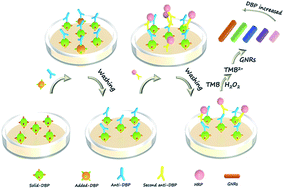Rapid detection of dibutyl phthalate in liquor by a semi-quantitative multicolor immunosensor with naked eyes as readout
Abstract
Excessive intake of dibutyl phthalate (DBP) can cause serious health problems. Hence, it is necessary to develop some simple yet sensitive method to monitor DBP level in foods. In this study, a competitive multicolor immunosensor for DBP detection has been proposed based on the etching of gold nanorods (GNRs) using naked eyes as readout. DBP was immobilized on the surface of the wells by physical adsorption (thereafter called solid-DBP) and used to capture anti-DBP antibody. The addition of target (called added-DBP) competes with the solid-DBP to combine with anti-DBP antibody, limiting the amount of anti-DBP antibody immobilized on the plate. A horseradish peroxidase (HRP)-labeled secondary anti-DBP antibody was then combined with anti-DBP to form an antigen-antibody-secondary antibody competitive complex on the well surface. The amount of HRP immobilized on the plate is therefore inversely proportional to the concentration of DBP in the sample. 3,3′,5,5′-tetramethylbenzidine (TMB) was oxidized to produce the oxidized form of TMB (TMB2+) in the presence of HRP, which etches GNRs to different degrees within 90 s. The etching results in vivid color changes in the system because of the changes in the localized surface plasmon resonance (LSPR) of the GNRs, and can be distinguished by the naked eye. The value of the LSPR shift (Δλ) of the GNRs is inversely proportional to the concentration of DBP in the range of 150–2700 μg L−1 (0.54–9.72 μM). The limit of detection was determined to be 76 ng L−1. This concentration-dependent multicolor immunosensor offers an easier approach to achieve semi-quantitative or qualitative detection results relative to the traditional system. The proposed multicolor immunosensor can be applied to detect DBP in liquor with satisfactory results, thus providing a promising platform for on-site application in resource-poor regions.



 Please wait while we load your content...
Please wait while we load your content...
